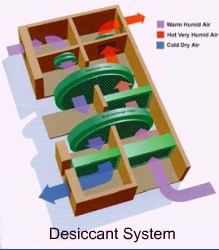Desiccant dehumidification systems are a cost-effective way to control humidity and improve indoor air quality. However, to optimize their effectiveness, they must be carefully designed and applied.
The variety of desiccant systems and materials available can seem daunting. Understanding how desiccants work and how they're best applied is critical to effectively incorporating them into any HVAC system.
Types of desiccant systems
Desiccants are materials that naturally absorb moisture. Commonly used desiccants include solids, such as silica gel or molecular sieves, and liquids, such as lithium chloride. For liquids, the solution is sprayed into the incoming air, removing the moisture. In a dry system, a rotating wheel containing solid desiccants continuously dehumidifies outside air entering the unit.
Passive desiccant systems use dry air (typically from building exhaust) for regeneration. Passive systems are limited in the amount of moisture they can remove from the incoming air and are ultimately restricted by the temperature moisture level of the exhaust air leaving the building.
Active systems use heated air for regeneration; they require a thermal energy source, typically natural gas. Although they're more expensive to operate, active desiccant wheels provide humidity control independent of weather conditions or the moisture level of building exhaust air.

Advantages of desiccants
Desiccant systems are very effective, and their use is well-established in applications such as ice arenas, supermarkets, schools, restaurants and indoor swimming facilities. The benefits of desiccants include:
- Improved indoor quality through better humidity control
- Increased effectiveness at minimizing mold and mildew problems
- Elimination of the extra step necessary in mechanical cooling to reduce humidity levels
Desiccant systems do present some challenges. They can be expensive to install, but the costs can be offset over time by energy savings. Desiccant units are relatively large and heavy and require careful installation, especially on rooftops. They also contain a large number of moving parts and require periodic maintenance.
Overall, however, desiccant dehumidification can be an effective way to improve the comfort, health and productivity of your facility while reducing your operating costs.

